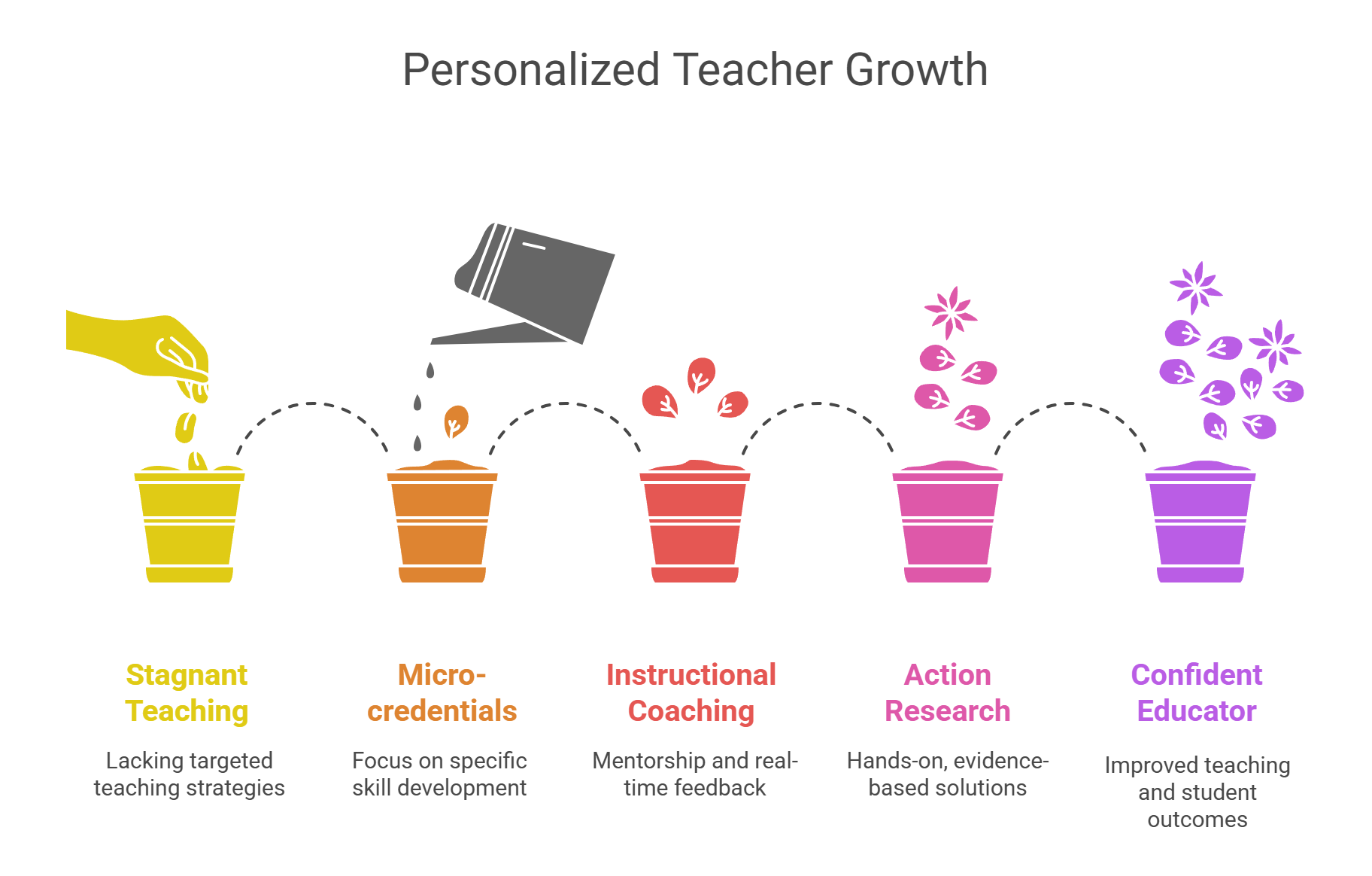
Want to improve your teaching skills? Discover seven innovative teacher professional development ideas. Explore personalized plans, instructional coaching, and more to enhance your growth as an educator in professional education.
Key Takeaways
- Personalized Professional Development Plans, including micro-credentials and instructional coaching, encourage tailored teacher growth and enhance teaching practices.
- Effective teacher professional development is essential for improving teaching practices and student outcomes, as it focuses on well-designed, impactful training programs.
- While there are many professional development opportunities available, selecting relevant and tailored options is key for meaningful teacher growth.
- Micro-credentials provide targeted skill enhancement in areas like STEM and cultural responsiveness, helping teachers to address specific skill gaps and improve student outcomes.
- Integrating professional development into daily teaching routines promotes a culture of continuous improvement, making learning relevant and supportive for both teachers and students.
Personalized Professional Development Plans

Teachers inspire students when their professional development matches their unique needs. Personalized plans deliver targeted training, helping educators grow in ways that improve teaching strategies and support student learning, especially for new teachers.
Think of a product tailored to your teaching style, addressing classroom challenges and aligning with your career goals. These plans keep teachers actively involved in their own growth, building a strong teaching career.
Now, let’s dive into specifics.
Micro-credentials allow teachers to focus on skills like STEM integration or trauma-informed teaching strategies, earning compact certifications.
That's not all. A study has confirmed that teachers using micro-credentials gained confidence in new classroom techniques, improving student outcomes. These credentials complement graduate programs, offering practical, budget-friendly professional development for continuing education.
Instructional coaching offers another path. Teachers work with mentors who observe lessons and provide real-time feedback, refining teaching methods like differentiated instruction or classroom management.
This collaboration builds confidence and job satisfaction, preparing educators to guide students effectively. Here’s the key: coaching creates a safe space to try new strategies, directly impacting student engagement.
What’s next? Action research empowers teachers to shape their professional development. Educators identify classroom issues, test evidence-based solutions, and reflect on results through a cycle of planning, action, observation, and reflection. This hands-on method supports a growth mindset, encouraging teachers to take ownership of their learning.

Micro-Credentials for Targeted Skill Enhancement
Micro-credentials reshape teacher professional development by offering focused certifications. Teachers target specific skills like culturally responsive teaching for middle school or EdTech integration via online learning, and earn credentials that demonstrate expertise. That way, professional development meets classroom needs, improving student learning and supporting career advancement.
Let’s explore how they work.
Platforms like Digital Promise offer micro-credentials that teachers can stack toward credits or leadership roles. Educators can also choose a professional development topic, such as Assessment for Learning or Self-Care, and apply skills to lesson plans. Confidence like this drives academic results and supports personalized learning.
The process is clear: teachers select a credential, engage with resources, document their practice, and submit evidence for evaluation. This practical method ensures skills apply directly to classrooms, making professional development meaningful.
And that's the bane of micro-credentials, empowering teachers to address skill gaps, boosting student outcomes and professional growth.
Instructional Coaching for Sustained Growth

Instructional coaching changes how teachers grow professionally. Mentors, including school leaders, observe classes, analyze data, and share feedback, helping educators refine teaching strategies.
With personalized guidance, teachers at every experience level sharpen their classroom management and teaching techniques, fueling a dynamic environment where students are more motivated and invested.
Here’s why it matters. A quantitative study found that classroom coaching led to an 11.1% increase in student engagement during class, and teachers made an average gain of 44.3% in their chosen instructional focus areas.
Building on this finding, coaching helps teachers master techniques like lesson planning and differentiated instruction, creating dynamic classrooms. Additionally, coaching supports new and experienced teachers alike, building confidence and job satisfaction.
Moreso, mentoring within coaching helps new teachers thrive. Experienced educators can share insights on family communication, workload management, and effective teaching strategies. Emerging research reveals that even in modestly sized studies, mentorship initiatives have helped new teachers achieve first-year retention rates of 80% or higher, demonstrating the powerful role support plays in keeping educators in the classroom.
This leads us to veterans. Coaches encourage collaboration, preparing teachers for roles like department chairs. Educators earning mentorship micro-credentials often become coaches, advancing their teaching career while supporting other teachers. Coaching ensures continuous growth, benefiting students and educators.
Action Research and Reflective Practice
Action research empowers teachers to transform classroom challenges into opportunities for growth. As a professional development strategy, it encourages educators to pinpoint issues, experiment with solutions, and reflect on the results, ultimately enhancing their teaching methods and student learning.
This approach also benefits student organizations, such as leadership clubs, by fostering a culture of continuous improvement. Through action research, teachers become active agents in their own professional development.
Let’s look at the process: The action research cycle, which includes planning, taking action, observing results, and reflecting on the experience, supports ongoing growth.
Teachers can use this approach to address challenges such as improving math skills or minimizing classroom disruptions, relying on data to guide and refine their teaching methods. Tools such as teaching portfolios help educators reflect more deeply and encourage collaboration.
The outcome? Teachers stay engaged, upholding ethical standards like student confidentiality. Plus, action research builds reflective practice, essential for effective professional development and student achievement.
The Power of Professional Learning Communities
Professional learning communities (PLCs) bring teachers together to share teaching strategies and improve student learning. Educators, school leaders, and specialists can collaborate on lesson plans, observe classrooms, and reflect on practices, including job training for new skills. Such cooperation builds a supportive culture, which in turn deepens the effectiveness of professional learning.
Let’s shift to benefits. PLCs thrive on peer collaboration. Teachers exchange classroom management techniques and test new strategies, boosting student achievement.
In fact, a University at Buffalo improved STEM participation by addressing gaps, enhancing instructional practices. PLCs increase job satisfaction, creating a positive school culture.
Also, online platforms like Nearpod can expand PLCs virtually. Teachers can share resources and discuss topics like trauma-informed teaching strategies, supporting professional development opportunities.
These communities offer certifications, emotional support, and practical tools, helping teachers deliver engaging lessons across school districts.

Technology-Enhanced Professional Development Modalities
Technology transforms teacher professional development with flexible, engaging options. Online learning platforms and blended learning courses allow teachers to learn at their own pace, supporting career advancement, especially for middle school educators. Tools like these make professional development accessible, fitting educators’ schedules.
Here’s how it works. Platforms like Nearpod offer interactive tools, stimulating discussions that improve teaching methods. Digital tools make lessons engaging, supporting classroom techniques.
Virtual reality platforms on the other hand like TeachLivE simulate scenarios, letting teachers practice leadership coaching or classroom management. Thanks to these dynamic modalities, teachers quickly acquire and implement new skills that translate into real-time benefits for their students.
This leads us to specifics. Sites like Smekens Education provide modules on student feedback, game-based learning, and special education. These courses support professional growth, equipping teachers with digital tools to improve student engagement throughout the school year.
Integrating Professional Development into Daily Teaching

To stay at the top of their game, teachers can embed professional development seamlessly into their everyday teaching lives. Top-notch micro-credential programs are designed to integrate smoothly into busy schedules, so professional growth naturally matches classroom realities. This way, educators can sharpen their teaching strategies effortlessly, reducing stress while consistently elevating student success.
Now, let’s explore an example. The Literacy Period framework integrates professional development through collaborative planning, peer observations, and action research during planning time. School districts can support this with mentorship and incentives, creating a culture of continuous improvement. That way, lessons are aligned with student needs, boosting engagement.
Why does this matter? Integrated professional development reduces unnecessary stress, encourages collaboration, and improves student learning. Teachers confidently try new classroom techniques, from personalized learning to effective lesson plans, creating a win-win for educators and students.
Here’s a quick checklist:
- Schedule brief professional development activities weekly.
- Collaborate with peers on lesson plans.
- Apply one new strategy to your teaching.
- Reflect on outcomes with a mentor or PLC.
Prioritizing Teacher Mental Health and Wellbeing
Teachers’ mental health should be prioritized for effective teaching and student learning. Heavy workloads and student behavior create stress, impacting wellbeing. Schools that offer professional development activities like stress management workshops and mental health support training, help teachers stay resilient and deliver engaging lessons.
This leads us to action. Teachers should prioritize self-care, which includes exercise, meditation, or family time, to recharge. These practices sustain passion for teaching, ensuring educators inspire students. By valuing mental health, schools build supportive environments, improving job satisfaction and student achievement across the school year.
Fostering Educational Leadership in the Classroom
When teachers step into educational leadership roles, they see transformation within their classrooms and beyond. Serving as mentors or collaborative team leaders, these educators motivate their colleagues and steer meaningful change, all while enhancing student learning through ongoing professional growth.
Leadership development programs equip teachers with the skills to facilitate project-based learning and to innovate with new instructional strategies, ensuring that every approach is thoughtfully aligned with the evolving needs of their students.
What’s next? Leadership training builds collaboration and critical thinking, supporting career advancement. Teachers model best practices, creating dynamic classrooms where students succeed.
Such leadership fuels ongoing professional advancement, equipping teachers and learners alike to excel in creative and adaptive educational spaces.

Summary
As we have seen, teacher professional development grows through innovative educational programs: personalized plans, micro-credentials, coaching, action research, professional learning communities, technology-enhanced courses, and daily integration.
These strategies cannot be overlooked as they improve teaching methods and student outcomes, supporting educators in guiding youth toward leadership and success.
When all of these are put together, teachers can thrive through collaboration and continuous learning, making a lasting impact on students.
Ready to empower your students with leadership skills? Explore 220’s online courses and join over 10,000 educators transforming lives.
Frequently Asked Questions
What are micro-credentials, and how do they benefit teachers?
Micro-credentials are small, specialized certifications that recognize teachers’ expertise in specific areas, such as educational technology, special education, or innovative teaching methods. These credentials can be earned through online courses, workshops, or other professional development opportunities, allowing teachers to focus on targeted skills that align with their career goals.
How does instructional coaching support teacher growth?
Instructional coaching is a powerful professional development strategy that offers teachers personalized, one-on-one support to refine their teaching practices. Through regular collaboration with instructional coaches, teachers can develop new skills in areas like classroom management, lesson planning, and differentiated instruction, receiving constructive feedback tailored to their unique needs.
What is action research, and why is it important?
Action research is a hands-on professional development strategy where teachers systematically investigate their own teaching practices to improve student learning outcomes.
How do Professional Learning Communities (PLCs) benefit teachers?
Professional Learning Communities (PLCs) are collaborative groups of teachers who work together to improve student learning outcomes and share best practices. Participating in a PLC provides teachers with a supportive network of colleagues, opportunities for meaningful collaboration, and access to new teaching strategies and resources.
What are some examples of technology-enhanced professional development modalities?
Technology-enhanced professional development modalities include online courses, interactive tools such as Nearpod, and VR simulations like TeachLivE, which provide flexible and engaging learning experiences. These options not only enhance engagement but also expand practical application in professional settings.